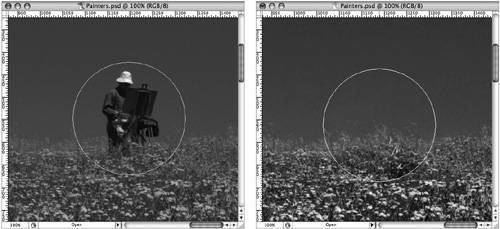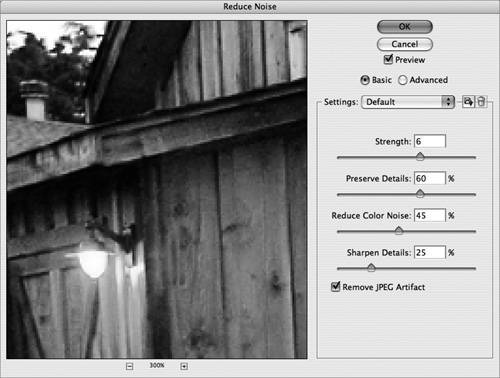Section 26. Repairing Image Flaws
#26. Repairing Image FlawsPhotoshop is considered the quintessential tool for retouching and repairing images. It can remove blemishes, crow's feet, and red eye, and re-create missing corners of old photographs as if by magic. And because those magicians at Adobe are continually improving upon the set of retouching tools and filters in Photoshop, it serves you well to know what's new and improved in CS2 for repairing images.
The Healing tools in Photoshop CS2 make it incredibly easy to repair defects in an image. The Healing Brush tool Figure 26a. Using the Spot Healing Brush, I was able to remove the painter in one click. In addition to the assortment of retouch tools Photoshop ships with, it also includes a handful of powerful filters to address overall problems that occur in photographs. For instance, the Lens Correction filter (Filter > Distort > Lens Correction) helps fix common lens flaws (Figure 26b), whereas the Reduce Noise filter (Filter > Noise > Reduce Noise) is specifically designed to help remove image noise and JPEG artifacts (Figure 26c). If your usual filters for dealing with noise are Despeckle or Dust & Scratches, it's time to give Reduce Noise a try. Figure 26b. The new Lens Correction filter makes it easy to correct common lens distortion issues such as barrel and pincushion distortion, chromatic aberration, and lens vignetting. Figure 26c. Digital imaging has brought forth such problems as JPEG artifacts, scanned film grain, and overall noise. The Reduce Noise filter eliminates these types of issues as fast as it was to make them. |
EAN: 2147483647
Pages: 143
- Assessing Business-IT Alignment Maturity
- Measuring and Managing E-Business Initiatives Through the Balanced Scorecard
- Measuring ROI in E-Commerce Applications: Analysis to Action
- Technical Issues Related to IT Governance Tactics: Product Metrics, Measurements and Process Control
- The Evolution of IT Governance at NB Power